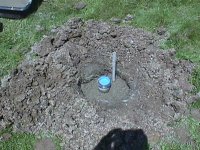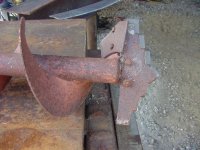Doggone it Don I can feel your pain.
Describe or link to your new augers.
Here's why I'd like to look at them. I've observed that when I hit the limestone the pilot bit goes right on down with out much of a problem. Let me know if you've found this to be the case.
A bud of mine who has a foundation company has a one and five eighths hex shaft twelve inch rock attachment. The way it's made might interest you. Instead of the usual pilot or fishtail with a flat area where the replaceable teeth are it has a couple of teeth. Then farther up a bit is another couple of teeth and so on until it's twelve inches wide. Sorta along the principal of a unibit if you're familiar with them.
If you put together my observation about the fishtail or pilot going in easy along with the unibit concept you might find something that will work with low down pressure.
I'm sure you're well aware of this but I'll remind you. There's a science to working a digging bar just like there's tricks to being efficient with a sledge hammer.
Most folks just slam the bar down into the hole. That's a lotta energy, throwing it down and then picking it back up again. Where I've had some success is I try to find a fissure or just wear one spot down and through. This really works with layered rock like it sounds like you have.
Then I pick and poke the edges of that hole into the hole until the hole is the size I can live with.
There's a little psychology to this method too believe it or not. The first thing is bouncing off the bottom and seeing just how much has got to break is very discouraging. But trying to just get a hole through means you're taking a little step. Then breaking off the edges into the hole is more little steps that are venturing into the land of the possible.
I can't tell you the times where I've walked over to a hole where a man was cussing and raving and wearing hisself and my patience thin only to break through with a couple of well placed hits.
It's watching the rock and when it shows a weakness jumping on it like it's an off colored stepchild that stutters when skeered.
One time a bud who was in AA came over with a nice young man who'd just got out of jail and part of his restrictions was attending AA and getting a job. Bud hit me up to give the kid a job.
First day out I was setting some posts around one of them bowels of hell apartment complexes where the drugs and such are so bad. The general contractor had pulled all the old posts with a tractor, concrete and all. I asked him about the old posts and he told me I could have them if I wanted them. They were eight foot C channel posts you see along the interstates, great posts and the price was right.
So I put the young man breaking off the concrete. They had been in three foot by one foot holes and it had been redimixed concrete, good stuff.
First one I took out my sixteen pound sledge with it's little kicker handle which makes it twenty two pounder. I call it papasan.
I hit the post about four whacks and the concrete split in two and I lifted the post out. Young man wanted that hammer. That was easy and he could excerise too.
I was working about fifty yards away from him. I watched him out of the corner of my eye. He slammed, he banged, he did it all but right. After about fifteen minutes he came over where I was at to get a drink and ask if it was okay to try another one cause that one wasn't gonna break.
I walked back over, hit it about three times, lifted the post out from the split concrete and handed the hammer back to him without a word and walked off.
This happened three more times. He's wail on that thing like it had dinged his pickemup and finally give up to have me walk up and hit it a couple of times and it'd split like a cedar stump.
When he was standing there with his tongue hanging out and his tail tucked so tightly between his legs that you had to look twice so see it I showed him my secret. I've learned they have to be ready to learn if you're gonna teach.
It's very rarely that the post is gonna be dead in the middle of the concrete. So you roll it to where you're hitting the thinnest side. You start at the bottom and work up watching for that crack you feel more than see. Sometimes you have to roll it ninety degrees for a kicker whack but not often.
He never did really get it but he did get some study time. And I do have to admit I've seen fewer people happier when the concrete broke. He knew he'd done something.
That same principle goes for working the digging bar. It's been my experience in this layered limestone that just about every hole has a spot where the rock is weaker than it is elsewhere. If you can find that then you're halfway home.
BTW when I have to set a post in a concrete slab I use the little hole and chip in method. I'll take my quick saw and cut a square just a tad bigger than my auger diameter. I'll take the Hilti with say a two inch bit and drill all the way through. Then I'll change over to a chisel bit and start breaking the edges off into that center hole.
I'm just lazier than the average bear, luckier too.



